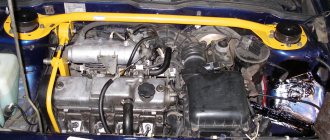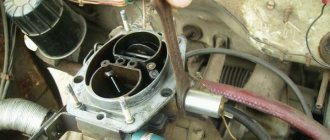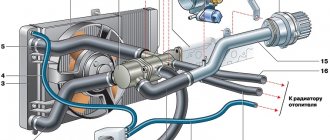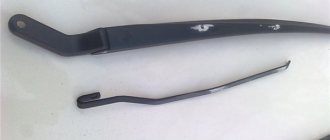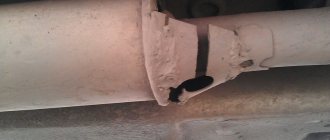Idle speed sensor
If the car jerks while driving, first you need to check the idle speed sensor. A malfunction of the idle speed sensor is very difficult to identify, since most often it does not cause a Check Engine error, which signals the presence of problems and shows which unit is not working.
There are three main faults
- Sensor contamination. The sensor is contaminated with oils, dust, oils, crankcase gases
- Mechanical damage associated with the rod, threaded connection, rivets flying out, etc.
- Failure of the electrical part. These malfunctions include winding combustion or a short circuit inside the sensor.
How to fix
It is better to immediately contact specialists at a car service center. This is what all owners usually say, who are not accustomed to doing their own repairs, do not show any initiative, and expect others to do everything for them. Yes, this is a good aspiration, but we warn you that today quite a lot of dubious auto repair shops are opening in the country, where it is unclear who works without the proper qualifications. Entrusting the work to an amateur is like signing a machine's death warrant.
This is not the only reason why a car owner decides to repair it himself. Sooner or later, every experienced motorist should be able to tune the operation of the “iron horse” so that it is always in shape.
So, the reasons for the failure of an injection engine are hidden in various factors
For example, here you need to switch attention from purely mechanical breakdowns to electronic ones. We are talking about the functions of electronics, its control of the injection system
To more specifically determine the cause, it is necessary to identify the type of failure. For example, in carburetor engines, the most common type of failure is a momentary lack of thrust, followed by a sudden jerk. This failure is explained by clogging of the carburetor or jets, failure of spark plugs, etc. An injection engine is characterized by twitching or rocking when a series of prolonged failures occurs.
Learn more about types of failures.
| Type of failure | What's happening |
| Short term failures | The engine does not respond to pressure for 2-3 seconds. |
| Long or prolonged dips | The power plant loses speed for 4-10 seconds, which is enough for a complete stop. |
| Jerks | Very short-term dips, lasting 1-2 seconds. |
| Twitching | A series of short-term dips, causing the car to either gain speed or slow down at the same position of the gas pedal. |
| Rocking up | A series of prolonged dips, acts like a twitch, but the time to gain speed and reset it is above 4 seconds. |
Owners of injection cars have noticed another type of failure, when it is when driving at medium and high speeds that an attempt to accelerate leads to the front end of the car pecking. The feeling is that you are sitting behind the wheel of a carburetor car with clogged jets.
In general, it should be understood that a disruption in the operation of the system leads to a change in the proportions of fuel assemblies. An excessively lean or enriched fuel assembly negatively affects the power plant; it is not able to increase speed when needed.
Thus, we can conclude that the first reason for the occurrence of failures on the injector is the pressure drop on the ramp. As you know, a parameter of 3 Bar is considered normal for an injection system. To eliminate failures (if the cause is pressure), you need to measure the pressure and compare the values with the standard ones. If the indicators are very different, then find the reason. It is possible that there is an air leak in the system or the injector is faulty.
Another reason may be the operation of sensors involved in the process of mixture formation. The sensors are responsible for the supply of fuel and air and regulate the crankshaft speed. To check all these details, it is enough to use standard instruments. They will make it possible to first test the pressure in the ramp, and then the condition of the sensors themselves. As for the general inspection of injectors, this is done using special equipment.
If the diagnosis of the reasons causing the failures yields nothing, you should definitely check the ignition system.
- Absolutely legal (Article 12.2);
- Hides from photo and video recording;
- Suitable for all cars;
- Works through the cigarette lighter connector;
- Does not cause interference to radios and cell phones.
Source
Ignition system
One of the reasons why the car jerks while driving may be a faulty ignition system. The ignition system consists of:
- Candles
- Ignition coils or module
- High voltage wires
- Distributor
- ECU
Depending on the car, some elements may not be present, but the essence does not change.
In order to ignite the fuel in a specific cylinder, a spark is needed. To form it, the ECU supplies a small voltage to the ignition module. The ignition module increases this voltage, and from it it is transmitted through high-voltage wires to the spark plug. If everything happened without any problems, then a spark appears at the spark plug and the compressed fuel mixture ignites.
If there are problems (most often this is a breakdown of any element of the system), then a spark does not appear on the spark plug, the fuel does not ignite and the car begins to twitch when driving at low speeds and during acceleration.
Fuel quality
The use of high-quality gasoline or diesel fuel is the key to long-term engine life and obtaining maximum power indicators from it. But none of the drivers is completely immune from refueling with low-quality fuel, the use of which threatens not only a significant reduction in power indicators, but also the inability to start the engine. Regular use of low-quality gasoline manifests itself in intensive formation of carbon deposits on the cylinders, pistons, catalyst and exhaust manifold, as well as increased wear of the cylinder-piston group.
Transmission
Sometimes the car jerks at low speeds due to the clutch. This may be due to the fact that the springs on the disk, which are needed for a smoother transmission of torque, have failed.
On some cars, for example the 8th generation Honda Civic, jerking when pressing the clutch is a disease and can be treated by lubricating the fork, which moves the release bearing. As for cars with an automatic transmission, kicks and jerks when starting off indicate that the automatic transmission is on the brink, and will most likely need to be repaired soon.
Electric gas pedal
A common reason when the car jerks is the failure of the electronic gas pedal. Modern cars have an electronic gas pedal. It works on the principle of a potentiometer and has a structure similar to it. Like any potentiometer, it has tracks along which the sensor runs. This sensor is mechanically connected to the pedal.
Although the gas pedal housing is hermetically sealed, it sometimes happens that moisture gets into it, and as you know, electronics do not like moisture. Since the tracks are made of metal, they begin to corrode. This reduces contact with the sensor. The pedal starts to work incorrectly and the car jerks when you press it. Dips are felt both at idle and while driving.
If the diesel engine doesn't work
A decrease in traction can also occur in diesel engines. If we look at old cars that have completely mechanical power systems, then the most common cause is depressurization of the system.
As a result, air enters the fuel, which is why the fuel injection pump is unable to provide the required pressure.
Don't forget about:
- clogged filters;
- weakly pumping fuel priming pump;
- damaged plunger pair;
- Coking of injector nozzles.
And if we also add possible problems with the timing belt and CPG, then identifying the cause will not be so easy.
In modern diesel installations, where an additional electronic component is used, the search range will increase.
For example, the Common Rail system uses all the same sensors as the injection engine. And if at least one of them breaks, this will certainly affect the operation of the control part.
Engine or gearbox mounts
The main car components, such as the engine or gearbox, are attached to the body using cushions. The main purpose of this device is to fasten and dampen vibrations during operation. Old cars often had cushions made of durable rubber, which rarely failed.
On modern cars, hydraulic mounts are installed. This device contains a special hydraulic fluid, and this type of pillows smoothes out vibrations better.
If the cushion bursts or has a tear, then at the beginning of the movement the car will jerk due to the fact that the main units do not have a strong connection with the body.
Steering
If the steering rack is faulty, it may well jerk when starting to move. Worn elements of this mechanism are usually not repaired - they are replaced with new ones. Also, the steering rack tips can dangle freely in their positions, which will cause jerks when accelerating sharply and when braking. In this case, the steering wheel wobbles. Damage to the steering column cannot be ruled out (usually this occurs in an accident), which can also create jerks when moving or starting.
If the steering mechanism is faulty, the driver should feel vibrations in the steering wheel, and not just jerks when starting off. And again, nothing can be advised to the driver regarding self-repair. Understanding the steering mechanism is no easier than understanding the gearbox system. So you have a direct route to the service station.
Engine temperature sensor
Modern cars are equipped with electronic engine control systems, which include many different sensors. Such sensors include the coolant temperature sensor. Its main purpose is to adjust engine operation depending on temperature.
If the sensor is faulty, the car engine will not operate properly. It will be difficult to start, the revs will drop, and there will be jerking when accelerating or just while driving.
Since the device is electronic, most often there is either a short circuit or a broken contact inside the sensor. In any case, if similar symptoms appear, it is better to replace the sensor.
Injector
The injector is another of the main systems through which the car can twitch while moving. The injection system includes many different devices. It is responsible for the formation and injection of fuel into the cylinders. Unlike a carburetor, an injector is more of an electrical device.
The car may jerk when driving at low speeds or when accelerating for the following reasons:
- Injector contamination
- Dirty throttle valve
- Failed mass air flow sensor
- Crankshaft position sensor
- ECU
As a rule, all problems that arise with the injector are accompanied by errors in the ECU and a burning chekEngine light on the dashboard.
Dips during acceleration
Most often, in the VAZ 2114 car, failures when pressing the gas injector occur during acceleration.
If you are faced with a similar situation, then the search for its problem should be carried out in the following sequence:
- If the spark plugs are oxidized or covered with soot, they should be cleaned with a cloth with kerosene or fine sandpaper (or replaced if they cannot be restored). In addition, the composition of the fuel mixture should be adjusted, since very often the cause of soot on the spark plugs is precisely its incorrect composition.
- Check the condition of the armored wires (to do this, their insulation should be measured using a megohmmeter and, if necessary, replaced with new ones).
- Check the condition of the throttle valve. If it is contaminated with plaque, it should be thoroughly cleaned (even a slight layer of plaque greatly affects the proper operation of the damper).
- Check the condition of the air filter, and in case of severe contamination or damage, replace it with a new one (it is worth remembering that the filter directly affects the correct composition of the combustible mixture, and therefore it should be checked periodically even during normal engine operation).
- If, after completing the above steps, the cause could not be found, then you should dismantle the fuel pump and check its functionality. At the same time, the fuel filter should be checked and, if necessary, replaced.
- Check the computer for errors (this can be done using a diagnostic computer. If it is not available, you will have to contact a car repair shop).
- Conduct diagnostics of the injectors and, if necessary, clean them (clogged injectors are the most rare cause of failures, but at the same time they are quite difficult to do on your own. If you cannot clean them yourself, you will have to contact a car service).
If on your VAZ 2114 failures occur when you press the gas injector while driving, then using the above plan you can easily find the causes of this phenomenon and be able to eliminate it.
Air filter
As we know, a large amount of air is needed to form a fuel-air mixture. The air passes through the car's air filter. A dirty filter is another reason why the car jerks while moving or when starting off.
When the air filter becomes dirty, there is not enough air. The mixture is over-enriched in fuel, which burns incorrectly in the cylinders.
The car begins to behave inappropriately, misfires appear, which in turn are expressed in drops in speed and jerking of the car.
How to Avoid Failures
Having talked about how to eliminate gas pedal failures that occur on a car, it is worth talking about how to completely avoid their occurrence. So, the most common cause of their occurrence is wear of the spark plugs. Therefore, you should always check their condition, prevent clogging and oxidation, and, if necessary, replace them.
In addition to spark plugs, high-voltage wires should also be periodically monitored (despite the fact that they have a long service life, core breaks and breakdowns of protection are far from uncommon).
Another very common cause is clogged filters, and especially the air filter. This element is a direct participant in the chain of formation of the working mixture, and that is why its contamination (or even damage) can immediately affect the operation of the engine.
Gasoline for VAZ 2114
The last thing you should pay attention to in order to avoid unpleasant gas failures is the quality of the fuel. If you notice that at the nearest gas station it has dropped significantly (and the car reacts to this), then you should not continue to use it - it is better to try to refuel at a pump of another company (or several companies)
In this way, you can find the highest quality gas station and ensure reliable operation of your car’s engine.
Why does the car jerk when driving?
Most often, the malfunctions listed above will cause the car to jerk while driving and work intermittently. But it is worth noting that each car is individual. Some cars have their own “childhood diseases” - design flaws that will cause this symptom. Such cars include the same Honda civic 8th generation; there was even a recall company for this fault, but the cause was soon discovered and learned to be eliminated.
A situation where a car starts to jerk for no reason can occur to every car owner several times a year. In most cases, the problem can be resolved quickly. At the same time, you need to understand that the maximum wear of some machine components can lead to a major overhaul of the affected systems. If the car stalls while driving and jerks with a loss of speed, then it’s time to take action.
“Personal” motives
The cases listed above are the main reasons why the steering wheel twitches when driving a VAZ-2114. Moreover, this is observed when starting or accelerating. However, it should be taken into account that each vehicle has individual characteristics, which are comparable to the human body.
In other words, each car has its own “diseases” and the appearance of the “symptom” in question is precisely due to the presence of design flaws.
Source
In what cases is a car “jerking” detected?
Most cases of car “jerking” are associated with problems with wear of spare parts or clogging of one of the car’s systems. While driving, you can detect vehicle twitching at the following stages:
- When starting only at the beginning of the car's movement;
- When driving at low speeds;
- During a sudden increase in speed;
- When driving at high speed;
- When driving in any mode (periodic shocks at different periods of time).
Consider the case of a vehicle malfunction when driving at low speeds.
What causes the car to jerk when running at low speeds?
Since the car begins to twitch when reaching even low speeds, it will not be possible to immediately identify one specific problem. Problems may be hidden:
- In the engine fuel mixture supply system;
- In the vehicle ignition system;
- At the checkpoint;
- In the distributor design;
- Includes fuel filters;
- In the sparking system;
- In the control unit of the vehicle's on-board computer.
Let's go through the faults in each of the listed systems in detail.
Tip: When detecting a “jerking” behavior in the vehicle, the brakes may also squeak when braking. These 2 problems can be either interrelated or indicate completely different breakdowns.
Checking the engine fuel mixture supply system
Often the reason that the car jerks at low speeds is due to a malfunction of the power system. When the car starts to move, the cylinders simply cannot receive the required amount of fuel mixture, as a result of which the car is unable to transfer the required amount of power to the chassis for smooth driving and smooth commissioning of the transmission. As a result of increased pressure and transmission resistance, uneven running of the machine appears.
To solve this problem, it is recommended that you first pay attention to checking the throttle body. It also wouldn’t hurt to test and diagnose the performance of the sensors installed in the system for determining idle speed indicators. Do not forget to check the serviceability of the throttle valve position and the mass air flow sensor.
Throttle body
During diagnostics, most often a breakdown is found in the injectors responsible for uniform injection of the fuel mixture. In rare cases, engine jerking problems may be related to the air ducts that connect the injector receiver to the air filter structure. Here the problem lies in depressurization of connections and loss of pressure.
The solution to the problem is to replace all faulty components yourself or with the help of car service specialists. After repair, it is recommended to ensure that all connections are in good working order and that there is no loss of pressure in the fuel line system that is connected to the fuel pump itself.
If a power unit with a carburetor system was installed in the engine compartment of your vehicle, then you need to check the idle valve and the absence of damage directly to the carburetor.
Checking the car's ignition system
Sometimes the car starts to jerk while driving at low speeds as a result of a breakdown in the ignition system. Basically, the problem will be caused due to untimely ignition of the fuel mixture and air flow. In rare cases, the malfunction may be hidden in the receipt of low voltage from the spark plugs. The spark voltage simply will not be enough to ignite the fuel mixture in a timely manner. Also, when diagnosing the ignition system, check:
- Performance of ignition coils;
- Serviceability of the spark plug set;
- No tears in high-voltage wires;
- There are no problems in the ignition distributor-interruptor (in simple terms - in the distributor);
- Correctness of values coming from a set of sensors responsible for the position of the camshaft and crankshaft;
- The performance of the switch located inside the entire structure.
Often, the car may jerk due to the long use of a set of spark plugs. There is often a situation where problems are caused by spark plug gaps not meeting established standards.
Advice: if the ignition module on a VAZ-2112 is faulty, the crankshaft position sensor will be damaged and it will not be possible to start the car’s engine at all. This problem can only be solved after a thorough check and subsequent repair of the knock sensor.
Checking the car gearbox
Jerking of a vehicle engine often occurs due to improper operation of the engine and infrequent maintenance of automatic transmissions. If the total mileage of your car is 100-200 thousand km, then even with a seemingly serviceable gearbox, the car will move with some jerks.
As a result of frequent jerking of the engine, the oil in the box foams, causing the amount of solution to be either too small or too large. Repairing a gearbox takes a little time. In a car service center, in just a couple of hours they will remove the box and restore its operation.
Problems with the accelerator
At the moment when the driver sharply presses the gas pedal, a rapid increase in engine speed occurs, which, in turn, can lead to ineffective operation of the vacuum ignition angle regulators. As a result, at low speeds the distributor will sink, and the car will begin to move jerkily.
Since, with the gradual combustion of gasoline, the driver begins to increase engine speed, the engine must ignite and let in the fuel and air mixture even faster. If there is a problem with the vacuum regulators, the car will not be able to quickly increase speed, which will cause problems with opening the throttle valve. Without the simultaneous opening of the damper and air supply, gasoline will not be able to burn in time, which can ultimately lead to damage to the bearing, which is responsible for the ignition timing.
To solve the problem, the vacuum regulators are first diagnosed. Here you can independently remove all the hose and pipes, having previously tightly covered them with your hands. When the engine is running, you will hear the retracting effect of the regulators working. If a vacuum does not form when the air mixture is supplied, it means that the seal is broken precisely because of the damper. You should replace it and assemble all components in the reverse order.
If the car starts to jerk at high speeds on an uphill road, then it is almost certain that it is low on fuel. Most likely this is due to a clogged fuel filter. Diesel engines may have three filters.
The engine does not pull: the main reasons for the decrease in engine power
So, if no other symptoms other than loss of traction are detected, then you immediately need to pay attention to the quality of the fuel, the proper functioning of the ignition and power systems. As practice shows, more than half of the cases of reduced efficiency from internal combustion engines are associated with fuel
The engine does not turn on due to the fact that the tank may be filled with low-quality or unsuitable fuel for this type of engine (for example, 92-grade gasoline instead of 95-grade gasoline)
As practice shows, more than half of the cases of reduced efficiency from internal combustion engines are associated with fuel. The engine does not turn on due to the fact that the tank may be filled with low-quality or unsuitable fuel for this type of engine (for example, 92-grade gasoline instead of 95-grade gasoline).
Typically, such manipulations are necessary when, parallel to the loss of traction, unstable operation of the internal combustion engine is noted, the speed jumps or floats at idle and under load, the engine does not start easily, the “check” light is on the panel, etc.
Also, owners of gasoline engines can independently determine the quality of gasoline by the spark plugs and their appearance. To check the spark plugs you need to unscrew them from the engine. A disruption in the combustion process of the fuel-air mixture in the cylinders, as well as the presence of impurities in the fuel, can be identified by soot on the spark plugs and its color.
For example, if the fuel contains a lot of third-party metal-containing additives and additives, then the skirt and electrodes may become covered with reddish soot (brick-colored). Black soot will indicate that the fuel is not burning properly, etc. In any case, malfunctions in the combustion process of the working mixture lead to the fact that the engine stops pulling.
The next step in diagnosis is checking the spark plugs. A decrease in the efficiency of these elements is also accompanied by a decrease in the power of the power unit.
This is especially noticeable during sharp accelerations, and when the car is already moving at high speed. In other words, the motor has no “reserve” left for further acceleration.
The candles may be dirty, and it is also possible that their life has come to an end. To fix this problem, you can clean the spark plugs or immediately replace the entire set with a new one.
If everything is in order with the spark plugs, then you need to check the condition of the fuel and air filters. In the first case, insufficient throughput can lead to the fact that the required amount of fuel is not supplied to the cylinders to prepare the so-called “power” mixture.

